Core Portfolios Annual Review
JANUARY 2020
From the reader’s perspective, this document should be read in conjunction with the “Pathfinder Portfolio Management Overview” report released on January 7, 2020 which explains our overall portfolio management process and investment thesis. Please follow this link here for a copy of the report if you have not seen it yet.
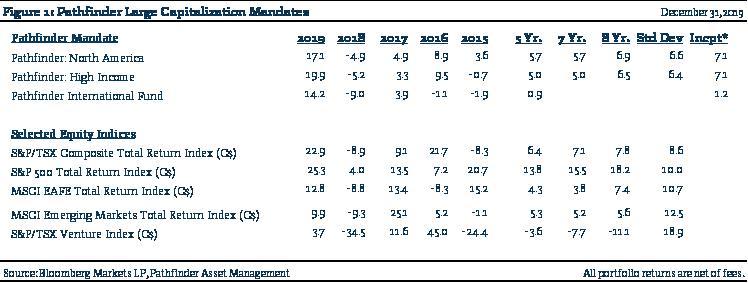
For the calendar year 2019, the North America Equity portfolio returned 17.1% and the High Income portfolio returned 19.9%, while the Pathfinder International Fund returned 14.2 % (please see Figure 1). Since our inception in 2011, both of our segregated portfolios have returned 7.1% annualized to December 31, 2019. We have accomplished this while taking less risk vs. equity markets – about two thirds of broad market indices, as measured by annualized standard deviation. Standard deviation, or volatility, is commonly used as a preferred measure of risk (i.e. the monthly fluctuations of your portfolio market value). We have been able to minimize our portfolio standard deviation with two main strategies. First, we invest in companies that are stable cash flow producers and that we believe are priced at a discount to their fundamental value. This inherently leads to less volatile portfolios. Second, when the quoted share price of the company’s equity rises above what we think will be the best-case scenario, we sell or reduce our investment and allocate that cash to another company that has better value. If we cannot find another company, then we hold the cash in a treasury bill. Holding the cash serves two functions: One, it reduces the risk of the portfolio when we believe prices are high and two, it provides us an option to buy more shares of good quality companies when those prices are lower. While there is an ever-present drive to improve, we remain satisfied with our results this year.
North American Equity & HIGH INCOME Review
As we noted in our 2019 Portfolio Management Overview released last week, 2019 was a very strong year for global equity markets. This came after a weak 2018, where many broad indices had a top to bottom drop of just under 20% (the technical definition of a bear market). The mood was dire coming into the beginning of 2019, but markets rallied for essentially the entire year. We present the results of the top and bottom counties in Figure 2. As you can see, it was quite a strong period for both smaller emerging market countries (green bars) and developed markets (blue bars).
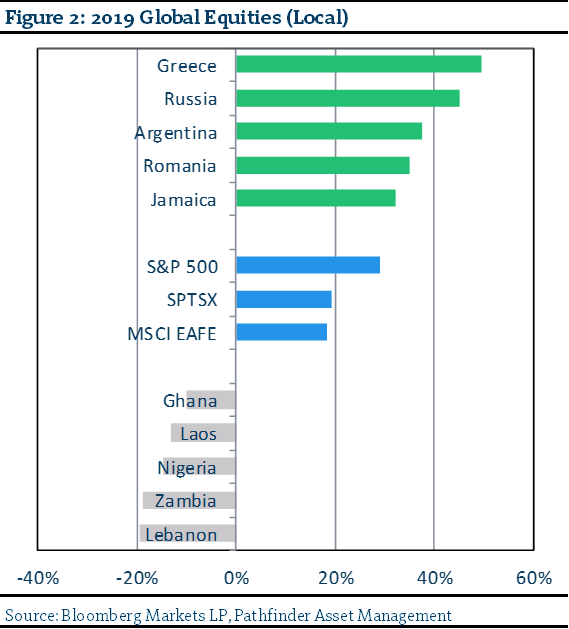
Our stock picking generated good results with the majority of our holdings providing double digit returns for the year. Our biggest win, was again, our large cap technology thesis: Apple Inc. (NYSE:AAPL) +86.2% and Microsoft Corp (NYSE:MSFT) +55.3%. Bank of America (NYSE:BAC) +42.9% and JP Morgan Chase & Co. (NYSE:JPM) +42.8% were also strong performers. We added the big US banks this year based on our investment thesis of improving margins from volume-based IT efficiency. While we continue to own all of these companies, we did take the opportunity to reduce our technology position sizes. In our opinion, valuations have pulled ahead of the firm specific fundamental developments and we would prefer to either allocate the capital to another part of the portfolio or hold cash. We also had strong results from long-time holding AT&T Inc (NYSE:T) (+36.9%) and the pipeline and midstream companies that we hold in the High Income Mandate: Gibson Energy Inc. (TSX:GEI) (+42.3%) and TC Energy Corp (TSX:TRP) (+41.9%). As for our losers, commodity stocks were again our worst performing group: Peyto Exploration & Dev Corp. (TSX:PEY) (-46.3%) Cameco Corporation (TSX:CCO) (-25.5%), Teck Resources Limited (TSX:TCK/B) (-23.3%) along with our US$ cash position, which drove the return dispersion between the two Core mandates (19.9% vs 17.1%). While for a number of years commodity stocks have been a very small portion of our portfolios and committed capital, they remain one of the areas where we see the most intrinsic value. Unfortunately, sentiment is poor and the economic back drop is less constructive, so for the most part, other than a small number of special situations, we remain on the sidelines.
We often discuss with our clients the difference between trading the market and investing in companies. At Pathfinder, we invest in companies. For our Core Mandates we aim to buy good quality companies with stable cash flows at a low price. This means that we often think about, calculate and debate the value of companies. It has generally been agreed upon that companies that offer the best value will, over time, provide the best performance results. For years we have noticed that companies that traditionally have offered the best value have also lagged the popular growth companies that tend to dominate financial headlines. We remain steadfast in our search for good valued firms, but this year did find it difficult to find good “buying candidates”. Consequently, we found ourselves holding more cash than we otherwise would have liked too. While we were satisfied with our performance results, we also miss the days when interest rates were higher, valuations were lower and there was more opportunity to invest in good quality companies at a fair price.
Pathfinder International Fund
International markets rebounded in 2019 mitigating the negative results from Japan, China and Emerging Markets, which all entered technical bear markets in 2018. For the year, the Pathfinder International Fund returned 14.2% while international markets as defined by the MSCI EAFE Index were up 12.8% in Canadian Dollar terms. We have been quite active in the fund, adding new companies in China and Japan after prices dropped in 2018. Our best performing international companies were: Anta Sports Products Ltd (HK:2020) +85.7%, Jd.Com Inc (US:JD) +68.3% and Alibaba Group Holding (US:BABA) +54.7%, while our worst was paradoxically the US dollar. We held too much cash (23%) which resulted in lost opportunity but also detracted from returns because of the strong Canadian Dollar. We continue to find more value-based opportunities to invest in Asia than North America & Europe, so Asia will continue to remain our focus for this year.
Portfolio Statistics
Figure 3 presents the difference between the portfolio characteristics of the Pathfinder Large Cap mandates to three large exchange trade funds. As you can see, the Pathfinder mandates do not look like any common benchmark portfolio. We are more concentrated, less exposed to cyclicals, have better valuation metrics and stronger company fundamentals. Over the years, our allocation to the sectors, geography and cash have changed dramatically. We take a real investment stance, move capital opportunistically and, as a result, expect a more efficient return profile.
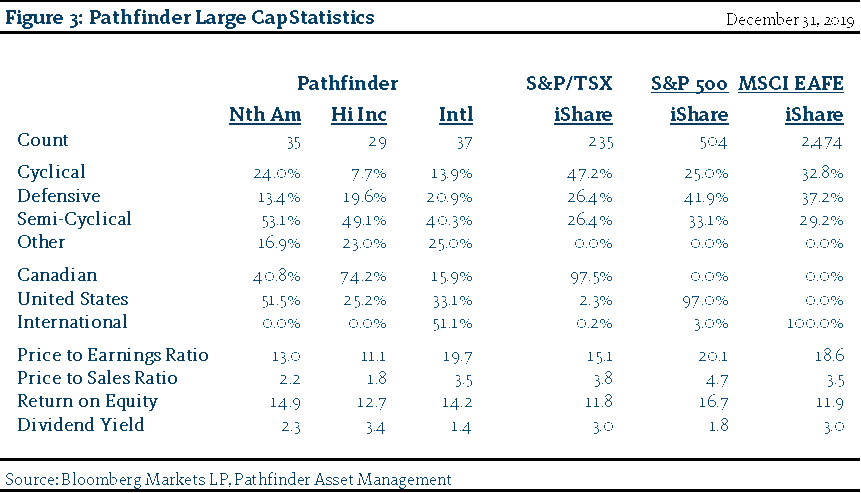
A Note about Fixed Income:
We have a number of clients where we blend in a laddered, investment-grade fixed income portfolio to their equity and fund positions for risk mitigation and capital preservation purposes. At this point in the investment cycle, and given the multi-year lows in interest rates, we do not use bonds in our portfolio as an active source of investment return. We remain allocated to bonds with “short” duration when bonds are required. Short duration bonds are a good way to preserve capital because they are less sensitive to interest rates. Given our view that we expect interest rates could increase over the medium to long-term we believe that this strategy will serve us better through that transition. We also believe that credit spreads are too small to warrant investment in most corporate bonds, given the level of absolute debt in financial markets. Consequently, we also tilt the portfolio more towards government bonds. We would need to see mid-to-high single digit bond rates with moderate inflation before we would again consider it as a contributing part of our investment process. Therefore, we prefer to use fixed income as a store of nominal value preferring to focus our portfolios on companies that we believe will have increasing cash flow resulting from increasing interest rates until this environment changes in favor of fixed income.
CURRENT INVESTMENT OUTLOOK
As always, I had a few ideas about what to write this year, but I took the time to reread last year’s Current Investment Outlook section before I began. Other than a few changes to the charts and some more interesting data points, I thought to myself “I should just reissue the same report as last year because nothing has changed”. In reality of course a lot has changed… valuations, geopolitics, central bank activity and debt levels but the basic fundamentals remain. With all of the financial press headlines and lofty stock market prices, I find myself circling back to our investment thesis: Buy good quality investments, don’t chase the market and be aware of and prepared for the change in the cycle. Below is the major point that we made last year:
The global economy continues to expand, albeit at a slower rate. Based on the performance of various financial markets (fixed income, equities and currencies) at the end of 2018 and the headlines in the financial press, one would expect that there was real and persistent economic contraction. We do not believe this to be the case.
We certainly did not foresee that equity markets would rebound so quickly and continue higher as they did, but as you can see, our focus on the data lead us to believe the opposite of what was consensus at the end of 2018. We could continue the same narrative for this year. The US consumer remains strong, unemployment remains at all-time lows, inflation is low, confidence remains high and US personal debt levels are also constructive. Throughout last year we wrote about our lack of conviction with respect to the industrial component of the US economy. We believed there was real concern about industry and that it was the US consumer that was essentially “holding it all up”. This year, we continue to believe the same but note two data points that we watch very closely have disconnected.
Figure 4 presents two Purchasing Managers Indices (PMI) for the US. PMIs are high frequency diffusion indices. A reading above 50 indicates expansion while one below 50 indicates contraction. The difference from 50 in either direction also indicates strength of either the expansion or contraction. We view PMIs as leading indicators and have previously presented this data in our weekly Investment Outlook reports to make the point that while growth has slowed, it is still positive. The two series presented here are produced by different firms but measure the same thing. The problem is that one says the US is rebounding and the other says it is contracting. We investigated this and note that the ISM survey asks managers to consider their whole operation, which could include businesses outside of the US, while the Markit PMI surveys similar companies but asks the managers to focus only on their outlook for their US operations. If we believe this explanation, then this is good news for the US economy but could be a warning signal for global trade uncertainty. A quick review of the manufacturing component of other large economy country PMIs indicates expected manufacturing weakness in those countries as well (UK 47.5, Germany 43.7, France 50.4, Canada 50.4, Japan 48.4 & China 50.2).
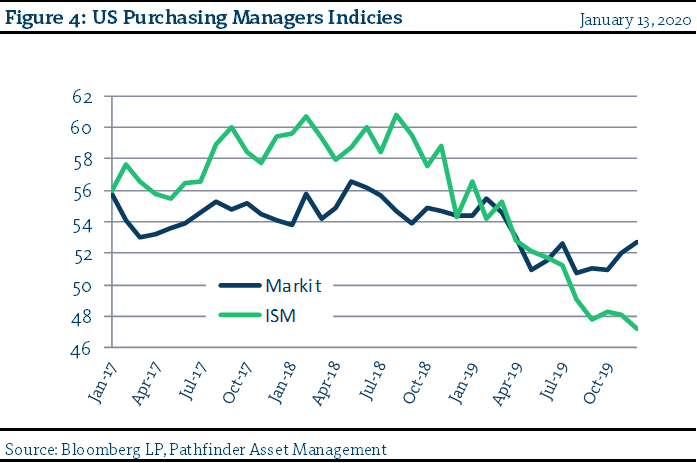
One of the most surprising developments for us last year was the about face that the US Federal Open Market Committee (FOMC) made with respect to interest rates. At the end of 2018, the FOMC expressed a definite bias towards increasing administered interest rates in attempt to manage what they believed was the potential for increased inflation. What they actually did was the opposite (i.e. they cut rates – Figure 5). That is the big lesson for us for this year. We will pay close attention to their actions rather than their words. Based on what they have done, the FOMC remains very accommodative to financial markets. We also note that other central banks around the world remain in lock step. In Europe, where there it seems there is continual structural disfunction, the European Central Bank remains focused on keeping interest rates low. The Japanese Central Bank has also entered into quantitative stimulus and China also recently announced another round of stimulus mostly, in our view, related to extending the economic cycle through the coming winter Olympics.
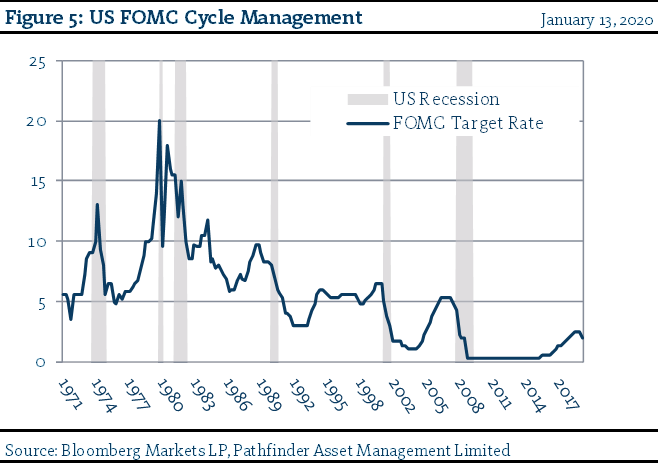
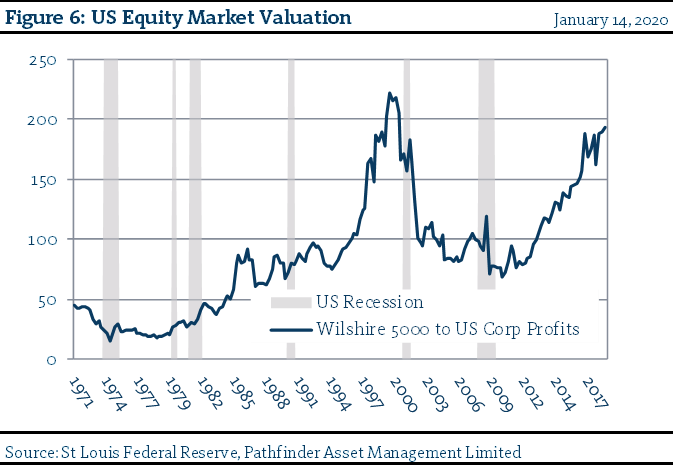
If the economy remains on track and central banks remain accommodative, then the next logical question is valuation. Figures 6&7 present three data series that are related to the valuation of the US stock market. The blue line in Figure 6 is data from the St Louis Federal Reserve. It presents the full market capitalization of the Wilshire 5000 divided by total US corporate profits. The Wilshire 5000 is “the market”. It contains essentially every publicly listed US company. The two lines in Figure 7 are Price to Sales ratios for both the Russell 1000 and the S&P 500 index. As you can see, depending on which metric you use, you could conclude that equity valuations are either high but not in bubble territory (i.e. the figure 6 is not as high as the dot.com era) or valuations are as high as they have ever been (Figure 7). If you are a regular reader of our weekly Investment Outlook, then you know that we prefer to use sales price valuation metrics for aggregate data because sales are harder to manipulate than earnings. Thus, the green lines are somewhat alarming. However, the main difference between 1999 and now is clearly interest rates. US 10-year Treasury yields on December 31, 1999 were 6.44% and at the end of this year they were 1.91%. What a difference 20 years makes! Interest rates have a direct correlation to the value of long-term assets (i.e. the lower the interest rate, the higher the valuation) and the companies that we own are essentially the longest dated assets that there are. Thus, the fixed income market and the actions of the various central banks are a major component of our view. While the absolute level of government interest rates is a major input, so is the spread between what the government pays to borrow and what businesses pay to borrow. Again, the lower the spread the better. I noticed the following quote from one of the most respected fixed income managers in the business that I think sums up the current situation very well.
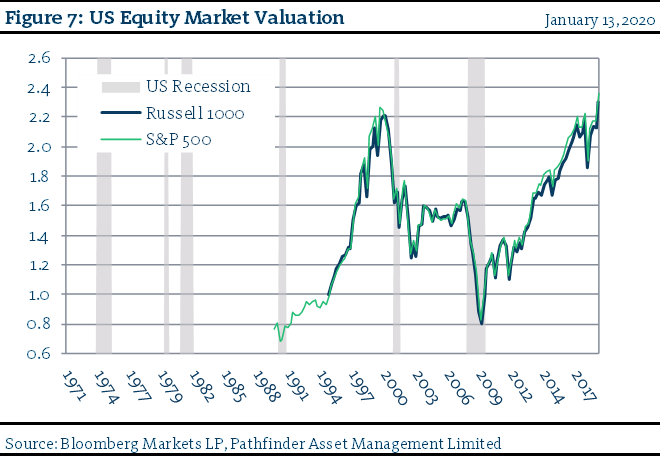
“The percentage of the investment grade corporate bond market that’s rated single A or higher is at an all-time low. It used to be two-thirds of the corporate bond market was rated single A or higher, 25 years ago. Now it is 35% of that market. So, the rating is actually worse. So, the yield spread should be higher than average. Not at near a low level. So, that is a very bad sign.” – DoubleLine Capital CEO Jeffrey Gundlach
Clearly with valuations so high, interest rates so low and with the potential for corporate spreads to increase it is hard to get excited about equity markets. Last year the economy grew slowly, and valuation multiples expanded. While we do not see multiples expanding again, we also do not see the economy growing any faster than its current trend. Over time investment returns revert to the mean. If our view that the economy continues along its current path is correct, then either the multiple holds steady and earnings and sales need to grow into the current valuations or the multiple returns to it historic levels and we have more downside volatility. In either case we are investing in real companies that are generating cash flow and retuning that cash flow to the owners, so we will remain focused on our investment process.
At the start of this section I wrote that I thought I should just reissue the report from last year. While I did not do that, I am going to end this year with the last section of last year’s report repeated. I also added our thoughts for 2020 in italics.
From January of 2019 with new comments in bold italics:
We draw the distinction between the economy, which is where the companies that we invest in operate and the financial markets, which is where the equity and bonds that represent those companies are quoted on a daily basis. The two can, from time to time, become somewhat disconnected, especially in the short-term. For many investors, recent market performance impacts their future investment outlook. For example, after excellent returns in 2017, most investors had a sanguine view for 2018, which in fact turned out to be exactly wrong. Furthermore, with the recent volatility at the end of 2018, many stock market prognosticators have decreased their expectations for market returns for the coming year. This of course turned out to be exactly incorrect as well. To us, the exercise of predicting market returns for the next year is futile and somewhat irrelevant to actual fundamental investing. There are many variables that can impact short-term prices: the FOMC’s administered rate path of the year, which had a massive impact on all global markets this year, large below investment grade debt levels which still have yet to have their impact on financial or economic markets, multiple trade wars, US government dysfunction, European structural stagnation, a potential slow-down in the Chinese economy, and other evolving geopolitical events. We watch these issues every day and they flow as inputs into our analysis, however, we remain focused on the businesses that generate cash flow on a regular basis and the economies that drive those businesses.
Core:100
We maintain a list of what we consider to be world class companies in all industries and across all major geographic areas. We regularly screen global stocks, based on our valuation framework, for new names that can be considered for addition to our universe of coverage. We focus on well managed, fundamentally strong firms that consistently generate and grow cash flow. We also expect strong quality management teams to reinvest that cash flow in improving their businesses. These firms have defensible advantages and ideally return any excess capital to their owners (i.e. us!!) in a rational, economic and consistent manner. The list is then filtered for qualitative factors including sector balance, general economic trends and changes in technology (even the best quality “betaMax producer” will not be a good investment!!) and we generate buy and sell targets for each company in the universe. This is what drives our portfolio investment decisions. Our thesis is that these companies should do better than the general market over the long-term and more importantly they should outperform during the regular periods of distress that we seem to have every 7-10 years. If we are buying from a list of “the best companies in the world” and buying at a discount, then the portfolios that we construct should do better on a risk-adjusted basis as well.
We try to include 100 names in the Core 100 (hence the name) but it has drifted higher as we find new additions and our investment thesis evolves to include more international companies. Generally, this is a slow-moving process that does not change significantly from year-to-year, but some evolution is healthy given global changes and the ongoing development of our investment view and process. Last year we noted that “we expect a more material change to the universe in the coming years as we increase our coverage list to include more companies that have revenue exposure outside of North America.”. To that end, this year we removed 14 companies from the North American universe, mostly because of M&A activity and business deterioration (i.e. potential value traps). Our screening process identified 130 companies for consideration and after reviewing each firm, we decided to add 35 to the North American and 16 to the International universes. We would expect to add another 20 or so going forward to the International Universe. This is a long-term, more strategic adjustment, as we believe that over time, economic leadership will come from beyond our continent, given changes in both demographics and geopolitical circumstances. Hence, we expect the number of companies that we follow in detail to increase towards 150. Figure 8 presents our current characteristics against large exchange traded fund portfolios.
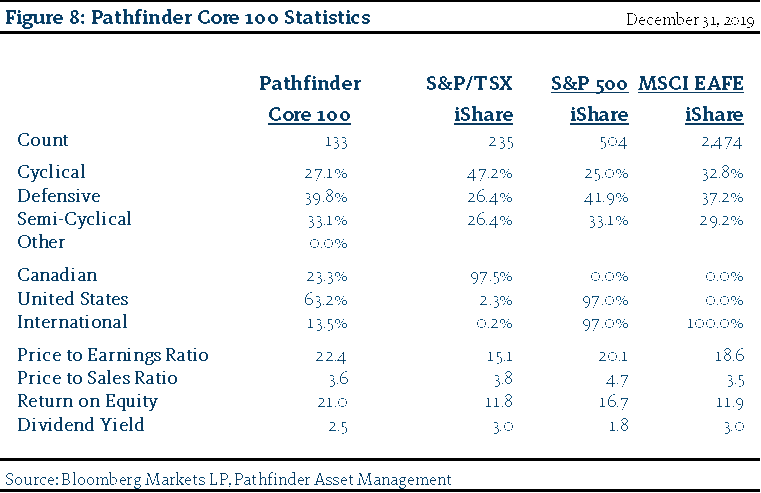
We are always looking to improve the quality of the companies that we consider for the portfolios. Each day we run the screen that identifies new companies that fit the broad parameters of what we consider to be a “good” company. The list is continually expanding and over the coming year it will be reviewed to determine if there is a potential fit for the Core 100.
National Instrument 31-103 requires registered firms to disclose information that a reasonable investor would expect to know, including any material conflicts with the firm or its representatives. Doug Johnson and/or Pathfinder Asset Management Limited are insiders of companies periodically mentioned in this report. Please visit www.paml.ca for full disclosures.
*All returns are time weighted and net of investment management fees. Performance returns from the Pathfinder Partners’ Fund and Pathfinder Real Fund are presented based on the masters series of each fund. The Pathfinder North American Equity Portfolio and the Pathfinder North American High Income Portfolio are live accounts. These are actual accounts owned by the Pathfinder Chairman (Equity) and client (High Income) which contain no legacy positions, cash flows or other Pathfinder investment mandates or products. Monthly inception dates for each fund and portfolio are as follows: Pathfinder North American Equity Portfolio (January 2011), Pathfinder North American High Income Portfolio (October 2012) Pathfinder Partners’ Fund (April 2011), Pathfinder Real Fund (April, 2013), and Pathfinder International Fund (November 2014).
Pathfinder Asset Management Limited (PAML) and its affiliates may collectively beneficially own in excess of 10% of one or more classes of the issued and outstanding equity securities mentioned in this newsletter. This publication is intended only to convey information. It is not to be construed as an investment guide or as an offer or solicitation of an offer to buy or sell any of the securities mentioned in it. The author has taken all usual and reasonable precautions to determine that the information contained in this publication has been obtained from sources believed to be reliable and that the procedures used to summarize and analyze such information are based on approved practices and principles in the investment industry. However, the market forces underlying investment value are subject to sudden and dramatic changes and data availability varies from one moment to the next. Consequently, neither the author nor PAML can make any warranty as to the accuracy or completeness of information, analysis or views contained in this publication or their usefulness or suitability in any particular circumstance. You should not undertake any investment or portfolio assessment or other transaction on the basis of this publication, but should first consult your portfolio manager, who can assess all relevant particulars of any proposed investment or transaction. PAML and the author accept no liability of any kind whatsoever or any damages or losses incurred by you as a result of reliance upon or use of this publication.